A Monitoring System for Measuring the Cognitive Cycle via a Continuous Reaction Time Task
Abstract
1. Introduction
- The first recorded action response signal;
- The full execution of a brief motor plan.
2. Theoretical Views
2.1. Attention as Internal Action
2.1.1. Two-Cause Internal Conjunction
2.1.2. Internal Actions and Automatic Unconscious Processes
- Occurs as a result of internal decision making;
- Is performed in parallel to the information provisioning of an AUP.
- The TIC phenomenon.
2.1.3. Knowledge Representation Framework
- A sensory stimulus—a new SI entity;
- The TIC from the last iteration of the cognitive cycle.
2.2. Discrete Motor Execution Hypothesis
2.2.1. The Deed Internal Action
- Continuous unconscious transmission: A constant transfer of information that proceeds throughout the cognitive cycle iteration. The internal agent cannot access the information that is being transferred.
- Continuous conscious transmission: A constant transfer of information that begins at a point in time when the internal agent is conscious. The internal agent is aware of the information that is being transferred.
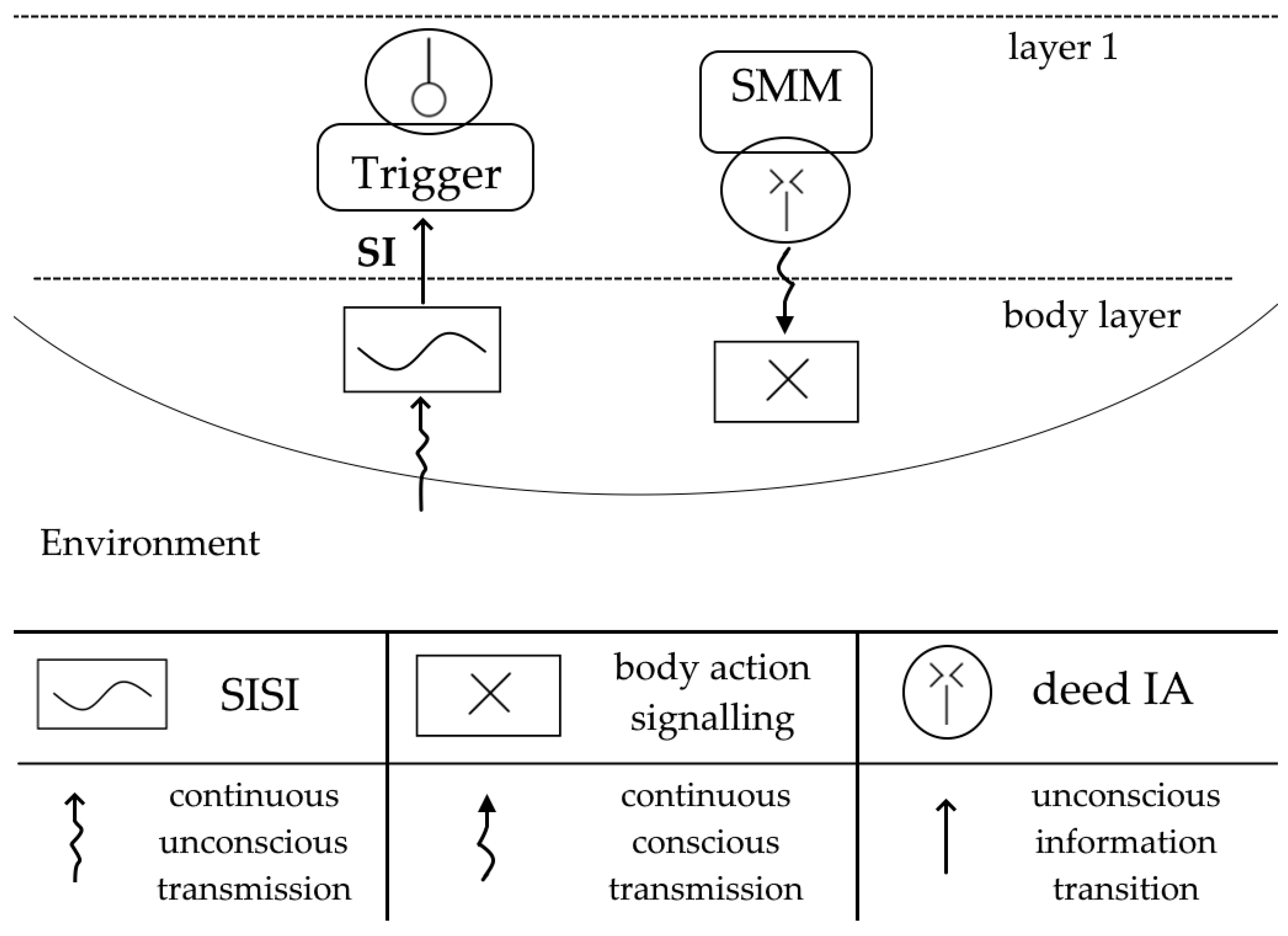
2.2.2. The Motor Plan of the Reaction Time Task
2.3. Measuring the Human Cognitive Cycle
2.3.1. Continuous Task Monitoring
- The task should be performed in full screen;
- The target stimulus should occur in an immediate manner—without animations;
- The stimulus onset asynchrony should be a multiple of the duration of the cognitive cycle;
- The stimulus onset asynchrony should be different in the trials;
- A click is considered the user input of two events, mouse button press followed by mouse button release;
- Upon a mouse button press when the button is still red, the button should immediately disappear, and negative feedback should be provided;
- Upon a click, when the button is green, the button should immediately disappear, and no feedback should be provided.
2.3.2. Computational Model
- Pressing the left mouse button;
- Releasing the left mouse button.
- 3.
- The disappearance of the button;
- 4.
- The appearance of the button in red;
- 5.
- The color of the button changes to green;
- 6.
- Negative feedback text saying “Bad click!” for one second;
- 7.
- Showing results after all the trials of the CRT task are finished.
- G: The number of cognitive cycle iterations between event (3) and event (4);
- W: The number of cognitive cycle iterations between event (4) and event (5);
- x: The time between events (5) and (2);
- y: The time between events (5) and (1);
- C: The duration of a cognitive cycle iteration;
- A: The duration of the IA phase of a cognitive cycle iteration.
2.3.3. Cognitive Cycle States
- The Perceived Stress Scale (PSS);
- Self-Assessment Manikins (SAM);
- The Karolinska Sleepiness Scale (KSS).
- H1: They have a higher level of stress;
- H2: They have a higher level of arousal;
- H3: They have a higher level of sleepiness.
3. Methods
3.1. Cognitive Monitoring System
3.1.1. The Experimental Task
- Determine the elapsed time since the last arrival in this step (delta time);
- Increase the value of M with this time;
- Set M to zero if a perceptual event occurs.
3.1.2. Intermediate Activity
3.1.3. System Parameters
- Reaction count: The number of successful trials which a user performed per single round in the CRT task;
- Muscle response time: The time required for “evoking hand muscle responses” [1];
- Iterations during pause: The count of CCIs during the time in which the user did not see the button;
- Iterations during pause after a bad click: The same as the above, but when a user clicked the button before it changed its color to green.
3.2. The Control Task
3.3. Data Analysis Methods
3.3.1. Comparing Reaction Times
3.3.2. Hypothesis Validation
3.3.3. Internal Action Durations
3.3.4. Cognitive Cycle Alteration
- dW: The count difference in W between two consecutive CRT trials;
- dC: The difference between two consecutive CCI durations;
- u: The count of wrong clicks produced in a round with the CRT task (pre-test or post-test).
3.3.5. Cognitive Cycle Consistency
- None: above 15 percent;
- Low: between 10 and 15 percent;
- Medium: between 5 and 10 percent;
- High: below 5 percent.
3.4. Experimental Setup
3.4.1. Participant Selection Criteria
- In both groups: denoted with the letters A, B, C, D and E;
- Only in the experimental group: denoted with the numbers 6–8;
- Only in the control group: denoted with the numbers 9–14.
3.4.2. Expectations for Participants
4. Results
4.1. Comparing the Reaction Times
4.2. Analyzing the Discrete Motor Execution Hypothesis
4.2.1. General Analysis of the Hypothesis
v > u,
v < l,
4.2.2. Analyzing Internal Action Durations
4.2.3. In Search for Alteration Interdependence
4.2.4. Analyzing Cognitive Cycle Consistency
5. Discussion
5.1. Further Analysis
5.1.1. Analyzing the Computed Durations
5.1.2. Ideas for Future Applications
- An average reaction time above the hypothesized duration of the cognitive cycle;
- Consistent IA phase duration (Section 4.2.2);
- Target stimulus waiting and CCI time interdependence (Section 4.2.3);
- CCI consistency (Section 4.2.4);
- The so-called “tenth trial jump” tendency (Figure 15).
5.2. Explanation for How Subjects Predict Target Stimulus
5.3. Critiques and Challenges
6. Conclusions
Author Contributions
Funding
Data Availability Statement
Conflicts of Interest
References
- Madl, T.; Baars, B.J.; Franklin, S. The Timing of the Cognitive Cycle. PLoS ONE 2011, 6, e14803. [Google Scholar] [CrossRef] [PubMed]
- Marks, D.F. The Action Cycle Theory of Perception and Mental Imagery. Vision 2023, 7, 12. [Google Scholar] [CrossRef] [PubMed]
- Banks, V.A.; Allison, C.K.; Plant, K.L.; Parnell, K.J.; Stanton, N.A. Using the Perceptual Cycle Model and Schema World Action Research Method to Generate Design Requirements for New Avionic Systems. Hum. Factors Erg. Manuf. 2021, 31, 66–75. [Google Scholar] [CrossRef]
- Plant, K.L.; Stanton, N.A. The Process of Processing: Exploring the Validity of Neisser’s Perceptual Cycle Model with Accounts from Critical Decision-Making in the Cockpit. Ergonomics 2015, 58, 909–923. [Google Scholar] [CrossRef] [PubMed]
- Ukov, T.; Tsochev, G. Reviewing a Model of Metacognition for Application in Cognitive Architecture Design. Systems 2025, 13, 177. [Google Scholar] [CrossRef]
- Ukov, T.G. Cognitive Monitoring of Learning as Experience via a Semiotic Framework for System Models. 2025. Available online: https://ssrn.com/abstract=5081756 (accessed on 1 July 2025).
- Tsochev, G.; Ukov, T. Explaining Crisis Situations via a Cognitive Model of Attention. Systems 2024, 12, 364. [Google Scholar] [CrossRef]
- Baars, B.J.; Franklin, S. Consciousness Is Computational: The LIDA Model of Global Workspace Theory. Int. J. Mach. Conscious. 2009, 1, 23–32. [Google Scholar] [CrossRef]
- Markus, A.; Eviatar, Z. Competition in Context: Response Selection within the Supervisory Attentional System Model. Cogn. Neuropsychol. 2023, 40, 43–57. [Google Scholar] [CrossRef] [PubMed]
- Kugele, S.; Franklin, S. Learning in LIDA. Cogn. Syst. Res. 2021, 66, 176–200. [Google Scholar] [CrossRef]
- Baars, B.J.; Franklin, S. How Conscious Experience and Working Memory Interact. Trends Cogn. Sci. 2003, 7, 166–172. [Google Scholar] [CrossRef] [PubMed]
- Marks, D.F. I Am Conscious, Therefore, I Am: Imagery, Affect, Action, and a General Theory of Behavior. Brain Sci. 2019, 9, 107. [Google Scholar] [CrossRef] [PubMed]
- Sun, Y.; Xue, X.; Li, Z.; Ma, H.; Zhang, D. Association of Visual Conscious Experience Vividness with Human Cardiopulmonary Function. Stress Brain 2023, 3, 80–95. [Google Scholar] [CrossRef]
- Franklin, S.; Baars, B.J. Two Varieties of Unconscious Processes. In New Horizons in the Neuroscience of Consciousness; John Benjamins Publishing Company: Amsterdam, The Netherlands, 2010. [Google Scholar]
- Kronsted, C.; Kugele, S.; Neemeh, Z.A.; Ryan, K.J.; Franklin, S. Embodied Intelligence: Smooth Coping in the Learning Intelligent Decision Agent Cognitive Architecture. Front. Psychol. 2022, 13, 846931. [Google Scholar] [CrossRef] [PubMed]
- Andrade, J. The Contribution ofWorking Memory toConscious Experience. In Working Memory in Perspective; Psychology Press: East Sussex, UK, 2001; pp. 66–68. [Google Scholar] [CrossRef]
- Yeung, N.; Summerfield, C. Metacognition in Human Decision-Making: Confidence and Error Monitoring. Philos. Trans. R. Soc. B Biol. Sci. 2012, 367, 1310–1321. [Google Scholar] [CrossRef] [PubMed]
- Wixted, J.T. Atkinson and Shiffrin’s (1968) Influential Model Overshadowed Their Contemporary Theory of Human Memory. J. Mem. Lang. 2024, 136, 104471. [Google Scholar] [CrossRef]
- Gurney, K.; Hussain, A.; Chambers, J.; Abdullah, R. Controlled and Automatic Processing in Animals and Machines with Application to Autonomous Vehicle Control. In Artificial Neural Networks—ICANN 2009, Limassol, Cyprus, 14–17 September 2009; Lecture Notes in Computer Science (Including Subseries Lecture Notes in Artificial Intelligence and Lecture Notes in Bioinformatics); Springer: Berlin/Heidelberg, Germany, 2009; Volume 5768 LNCS. [Google Scholar]
- Cieslik, E.C.; Mueller, V.I.; Eickhoff, C.R.; Langner, R.; Eickhoff, S.B. Three Key Regions for Supervisory Attentional Control: Evidence from Neuroimaging Meta-Analyses. Neurosci. Biobehav. Rev. 2015, 48, 22–34. [Google Scholar] [CrossRef] [PubMed]
- Baars, B.J. The Global Workspace Theory of Consciousness: Predictions and Results. In The Blackwell Companion to Consciousness; Wiley: Hoboken, NJ, USA, 2017; Volume 16, pp. 227–242. [Google Scholar] [CrossRef]
- Marks, D.F. Phenomenological Studies of Visual Mental Imagery: A Review and Synthesis of Historical Datasets. Vision 2023, 7, 67. [Google Scholar] [CrossRef] [PubMed]
- Boccaccio, F.M.; Pennisi, A.; Guerrera, C.S.; Platania, G.A.; Torre, V.; Varrasi, S.; Vezzosi, V.F.; Coco, F.; Castellano, S.; Pirrone, C. Mental Imagery between Cognition and Emotion: A Narrative Review. Psychiatry Int. 2024, 5, 697–717. [Google Scholar] [CrossRef]
- Marks, D.F. Consciousness, Mental Imagery and Action. Br. J. Psychol. 1999, 90, 567–585. [Google Scholar] [CrossRef]
- Alexander, W.H.; Brown, J.W. Computational Models of Performance Monitoring and Cognitive Control. Top. Cogn. Sci. 2010, 2, 658–677. [Google Scholar] [CrossRef] [PubMed]
- Vallence, A.M.; Rurak, B.K.; Fujiyama, H.; Hammond, G.R. Covariation of the Amplitude and Latency of Motor Evoked Potentials Elicited by Transcranial Magnetic Stimulation in a Resting Hand Muscle. Exp. Brain Res. 2023, 241, 927–936. [Google Scholar] [CrossRef] [PubMed]
- Woods, D.L.; Wyma, J.M.; Yund, E.W.; Herron, T.J.; Reed, B. Factors Influencing the Latency of Simple Reaction Time. Front. Hum. Neurosci. 2015, 9, 131. [Google Scholar] [CrossRef] [PubMed]
- Lauridsen, M.M.; Mikkelsen, S.; Svensson, T.; Holm, J.; Klüver, C.; Gram, J.; Vilstrup, H.; Schaffalitzky de Muckadell, O.B. The Continuous Reaction Time Test for Minimal Hepatic Encephalopathy Validated by a Randomized Controlled Multi-Modal Intervention-A Pilot Study. PLoS ONE 2017, 12, e0185412. [Google Scholar] [CrossRef] [PubMed]
- Harris, K.M.; Gaffey, A.E.; Schwartz, J.E.; Krantz, D.S.; Burg, M.M. The Perceived Stress Scale as a Measure of Stress: Decomposing Score Variance in Longitudinal Behavioral Medicine Studies. Ann. Behav. Med. 2023, 57, 846–854. [Google Scholar] [CrossRef] [PubMed]
- Vodyaho, A.; Postnikov, E.; Vasiliy, O.; Zhukova, N.; Chervontsev, M.; Klimov, N. Computational and Technological Models of Cognitive Monitoring Systems. Adv. Sci. Technol. Eng. Syst. J. 2019, 4, 197–202. [Google Scholar] [CrossRef]
- Ukov, T.; Tsochev, G. Application of Genetic Algorithms in the Multiplayer Video Game “Hram Light” for Personal Qualities Training; AIP Publishing LLC: Melville, NY, USA, 2023; p. 030003. [Google Scholar]
- Ukov, T.; Tsochev, G. Machine Learning Algorithm for Intelligent Bots in Multiplayer Video Game: A Case Study. Int. J. Inf. Technol. Secur. 2022, 14, 67–78. [Google Scholar]
- Tsochev, G.; Ukov, T.; Rusev, A.; Sharabov, M. Insights into Applying Artificial Intelligence Methods in Action Video Games for Enhancement of Psychomotor Skills. Eng. Proc. 2024, 70, 50. [Google Scholar]
- Tsochev, G.; Ukov, T.; Rusev, A.; Sharabov, M.; Trifonov, R. Directing Analysis on Conducted Experiments for Researching the Effects of Training with A Video Game. In Proceedings of the 2024 12th International Scientific Conference on Computer Science (COMSCI), Sozopol, Bulgaria, 13–15 September 2024; IEEE: Piscataway, NJ, USA, 2024; pp. 1–4. [Google Scholar]
- Dye, M.W.G.; Green, C.S.; Bavelier, D. Increasing Speed of Processing With Action Video Games. Curr. Dir. Psychol. Sci. 2009, 18, 321–326. [Google Scholar] [CrossRef] [PubMed]
- Drengner, J.; Jahn, S.; Furchheim, P. Flow Revisited: Process Conceptualization and a Novel Application to Service Contexts. J. Serv. Manag. 2018, 29, 703–734. [Google Scholar] [CrossRef]
- Lieberman, M.D. Intuition: A Social Cognitive Neuroscience Approach. Psychol. Bull. 2000, 126, 109–137. [Google Scholar] [CrossRef] [PubMed]
- Kaufman, S.B.; DeYoung, C.G.; Gray, J.R.; Jiménez, L.; Brown, J.; Mackintosh, N. Implicit Learning as an Ability. Cognition 2010, 116, 321–340. [Google Scholar] [CrossRef] [PubMed]

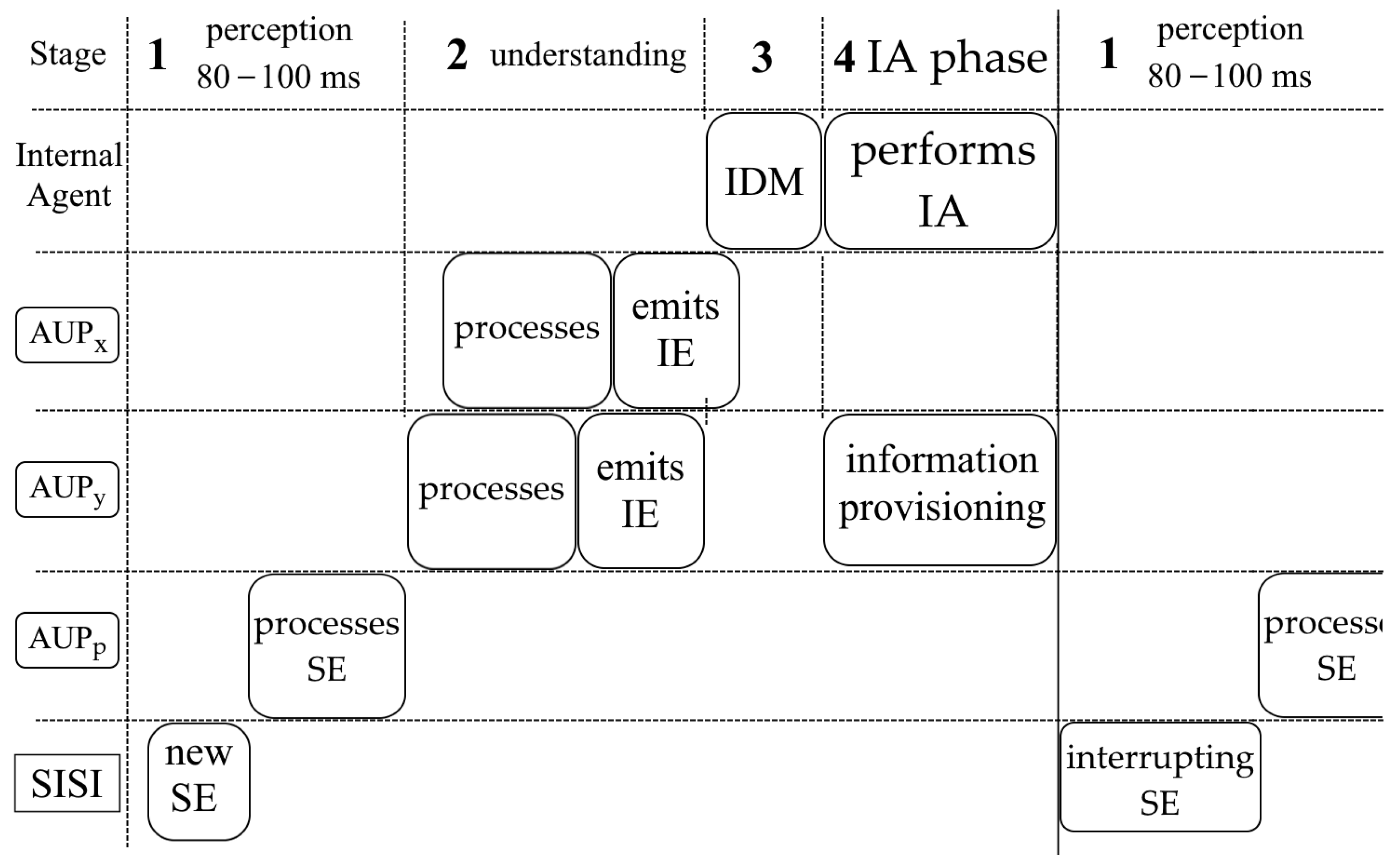

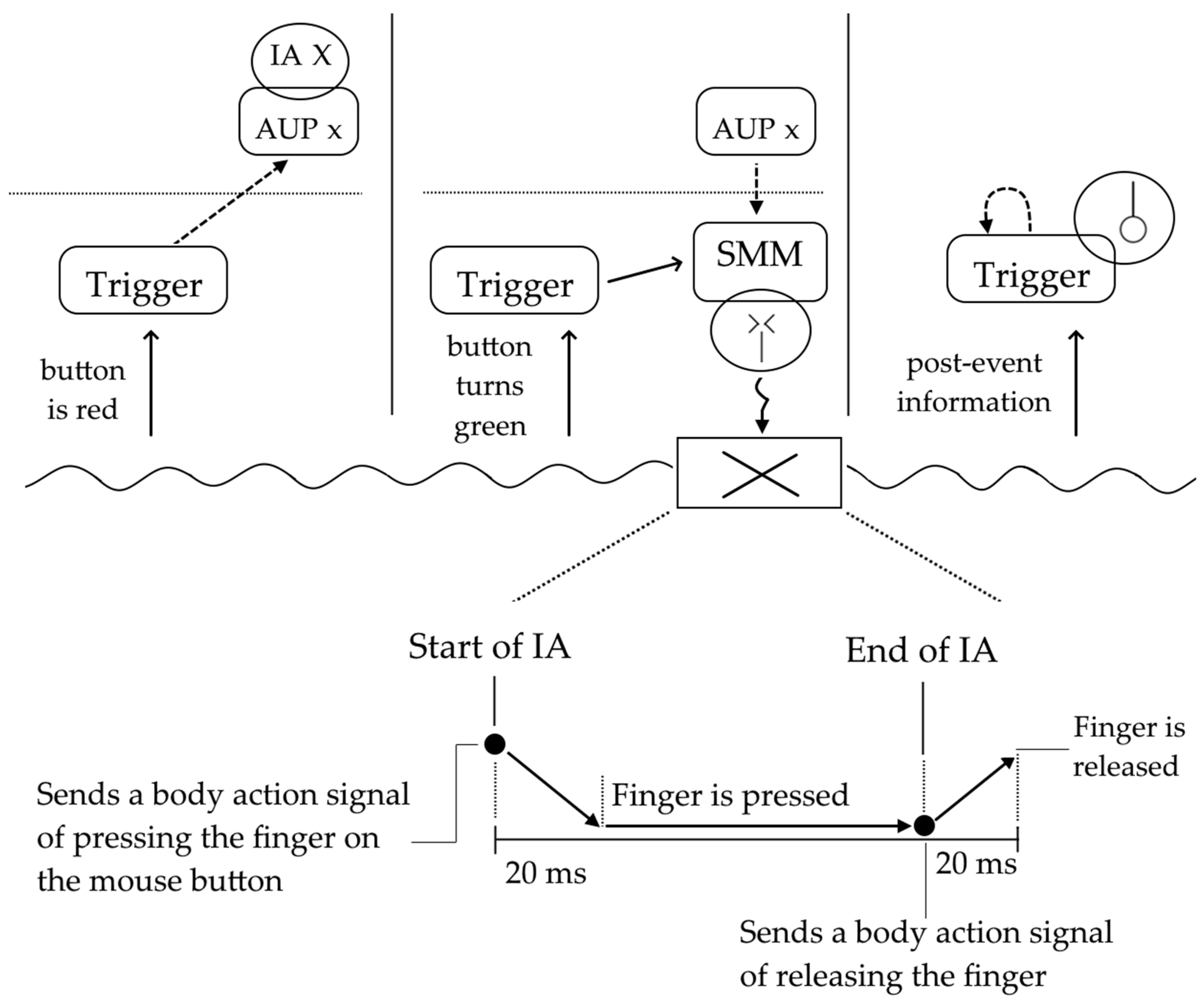
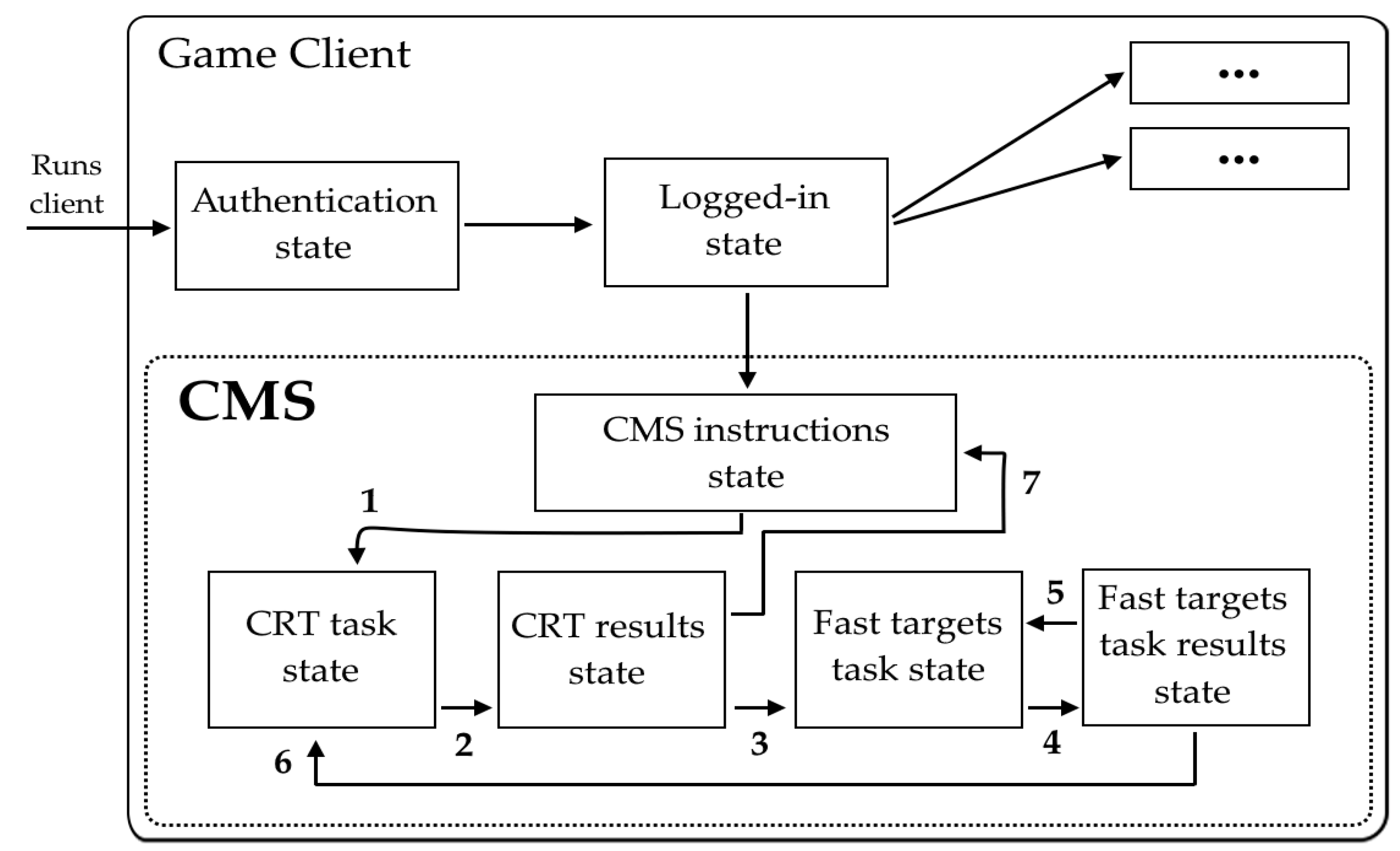


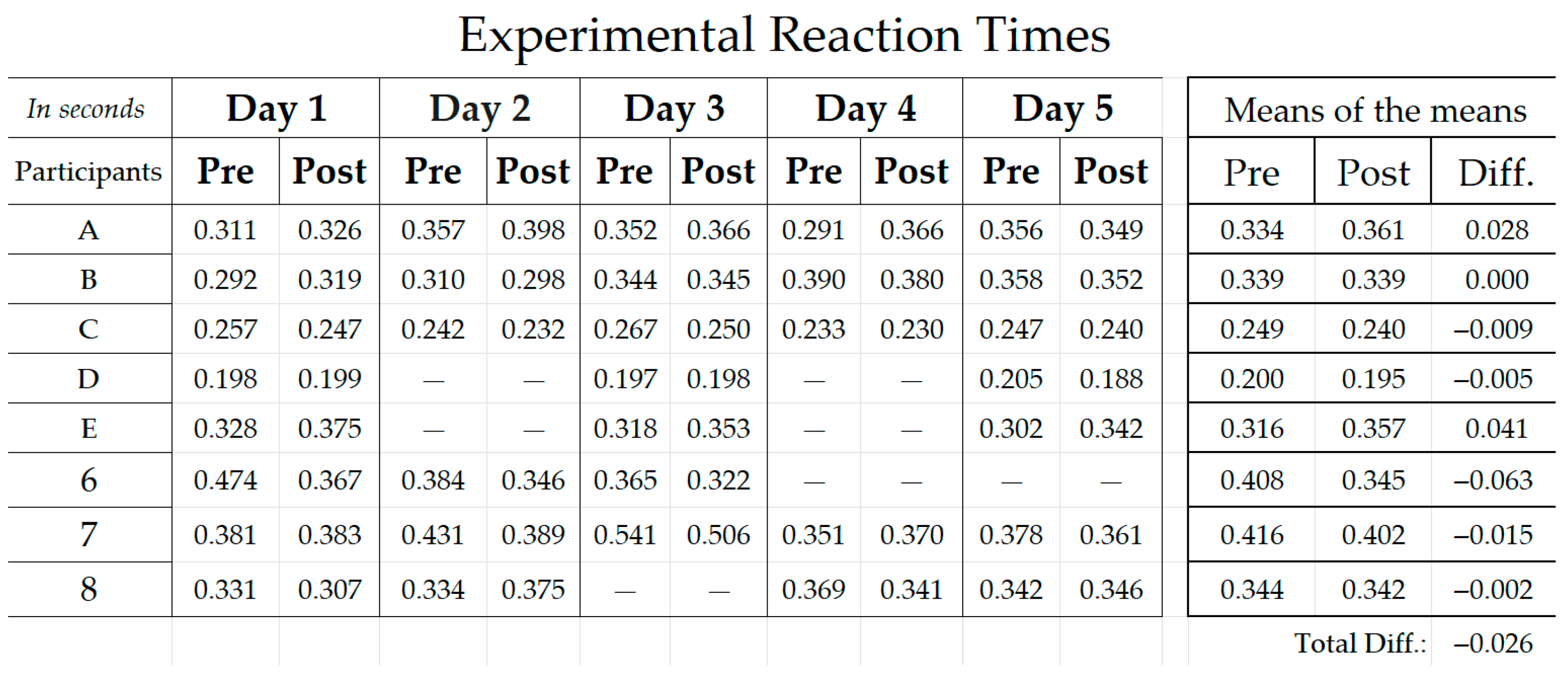
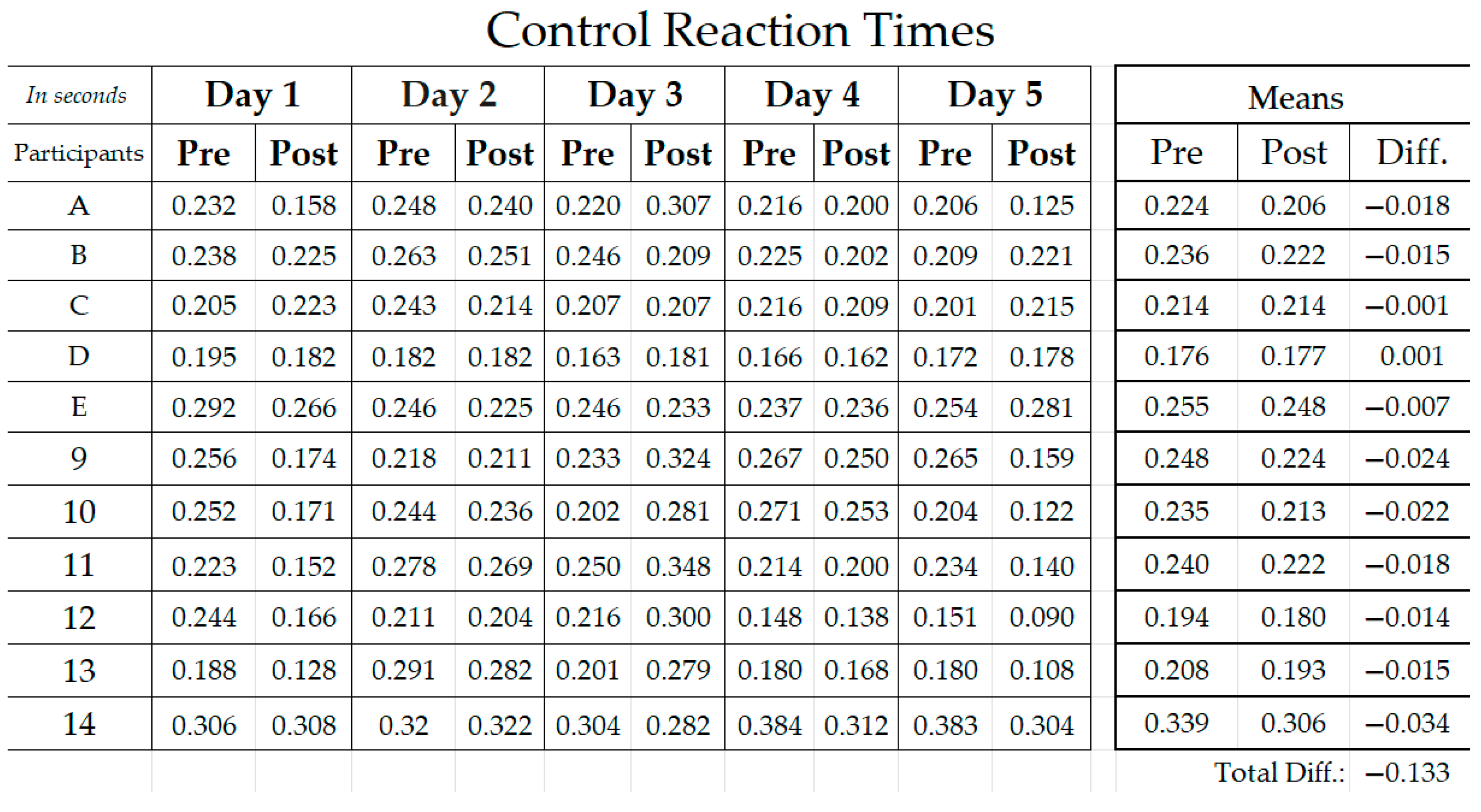
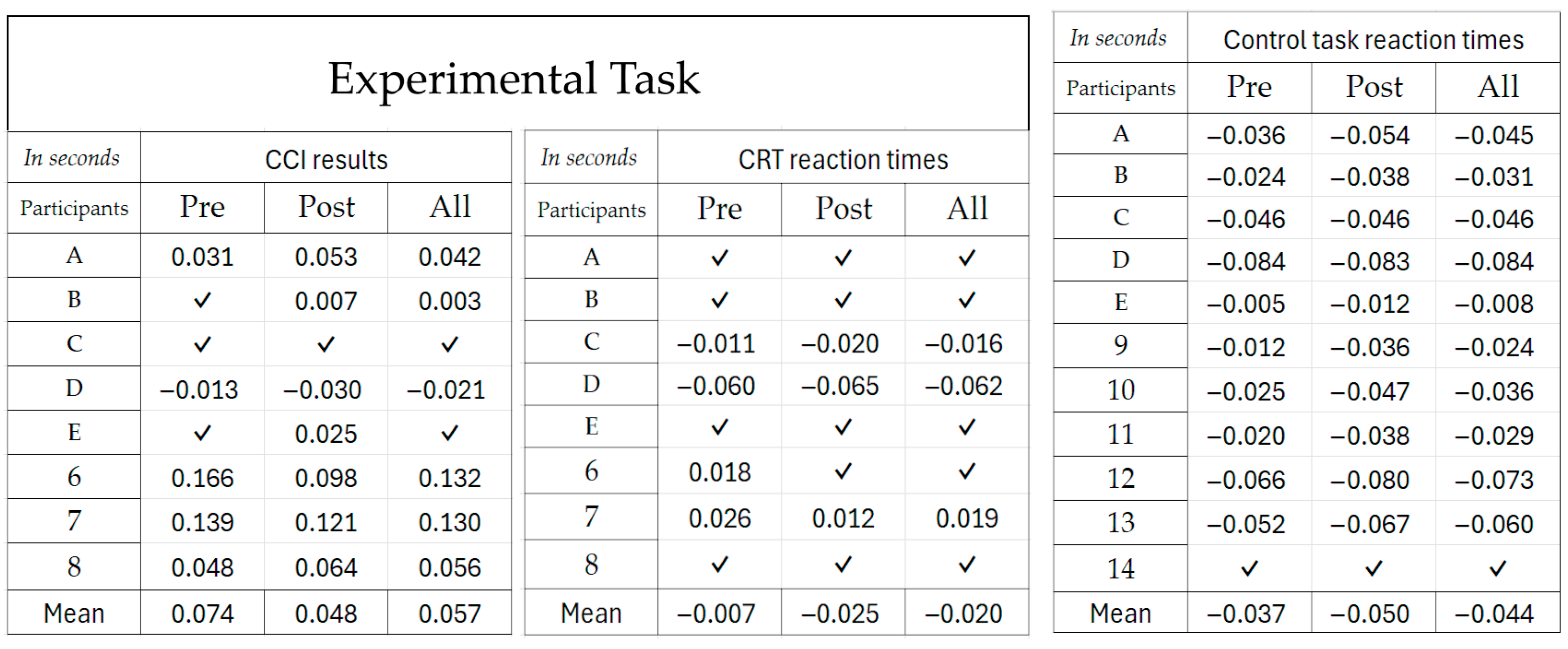



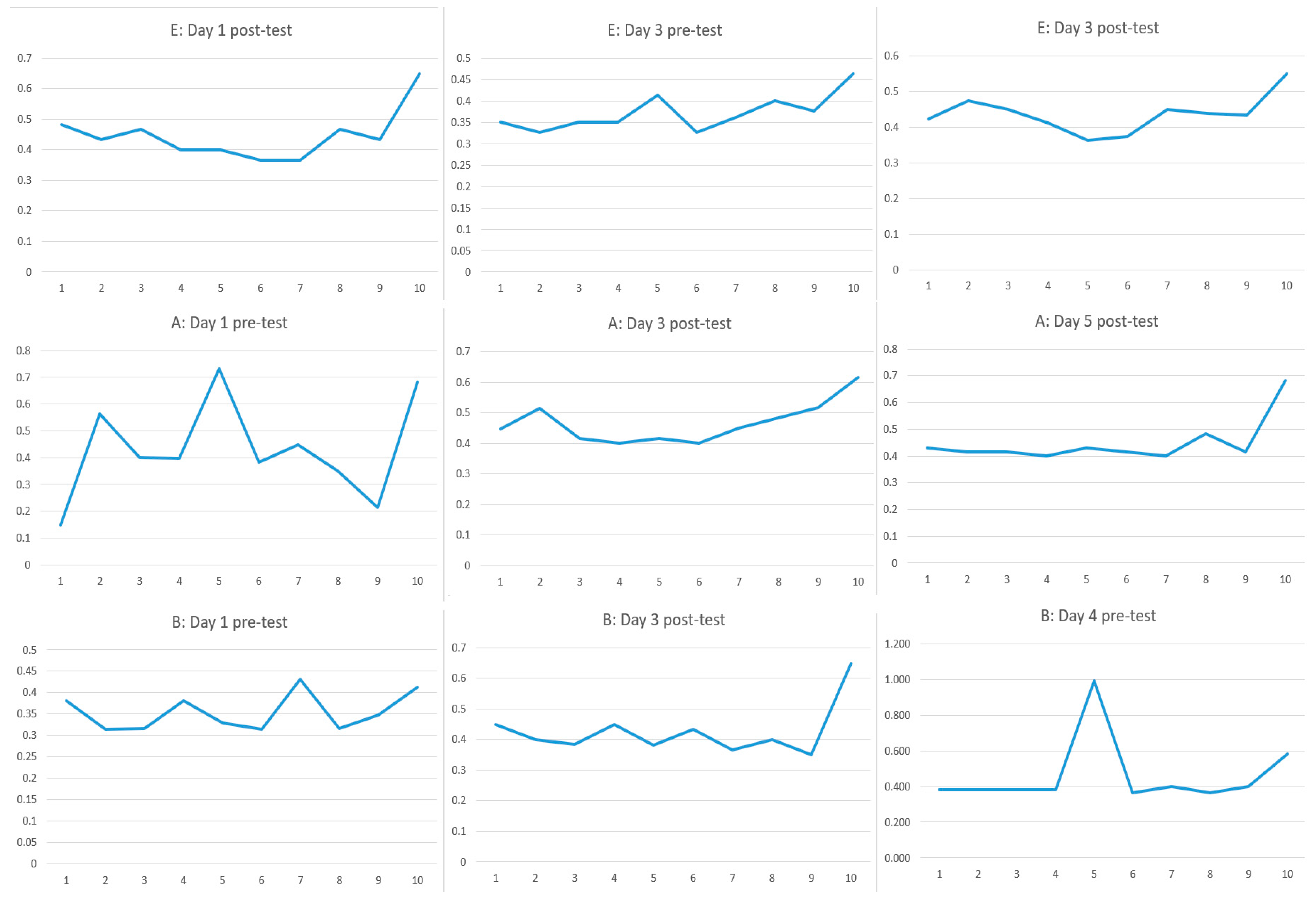
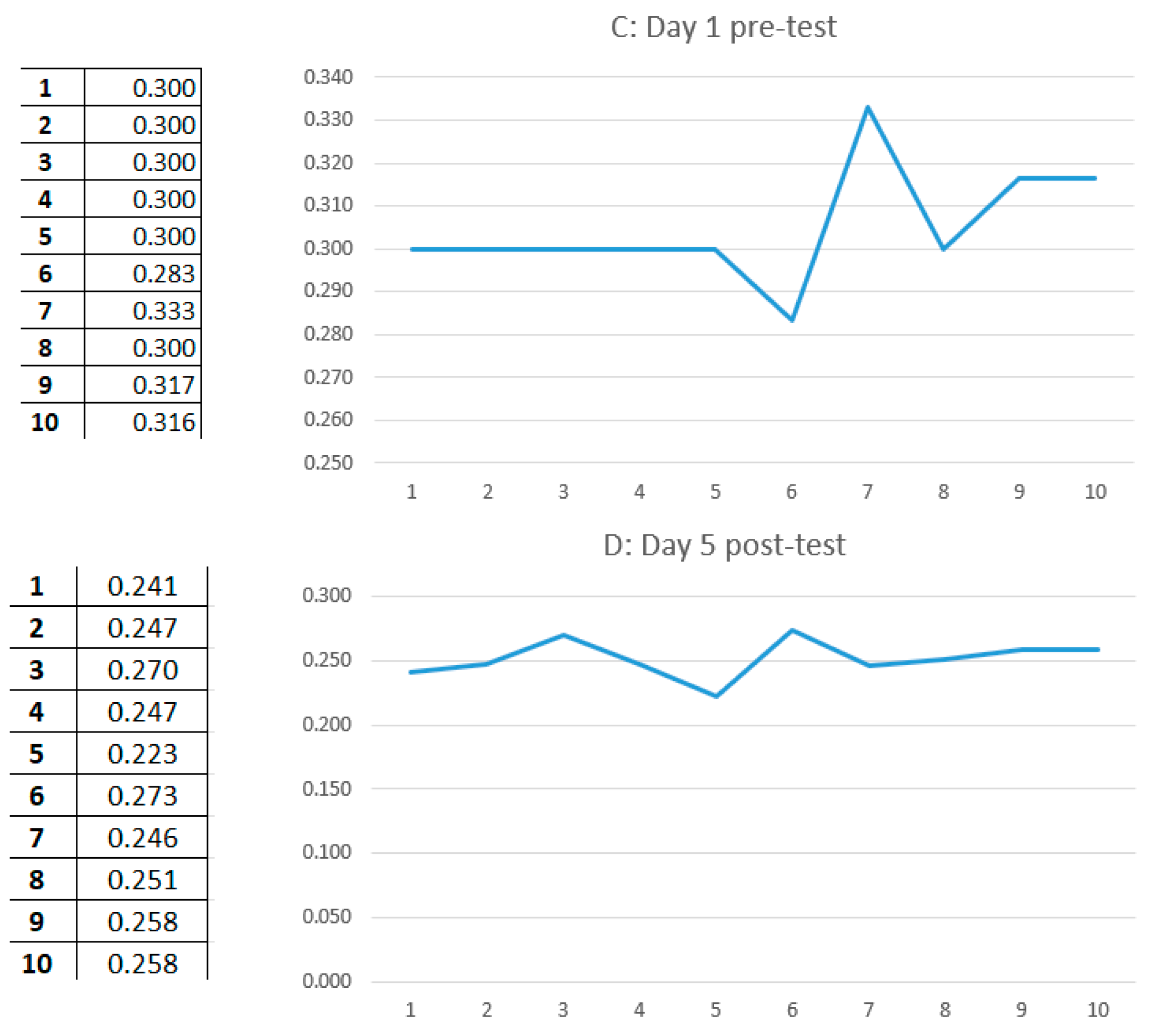


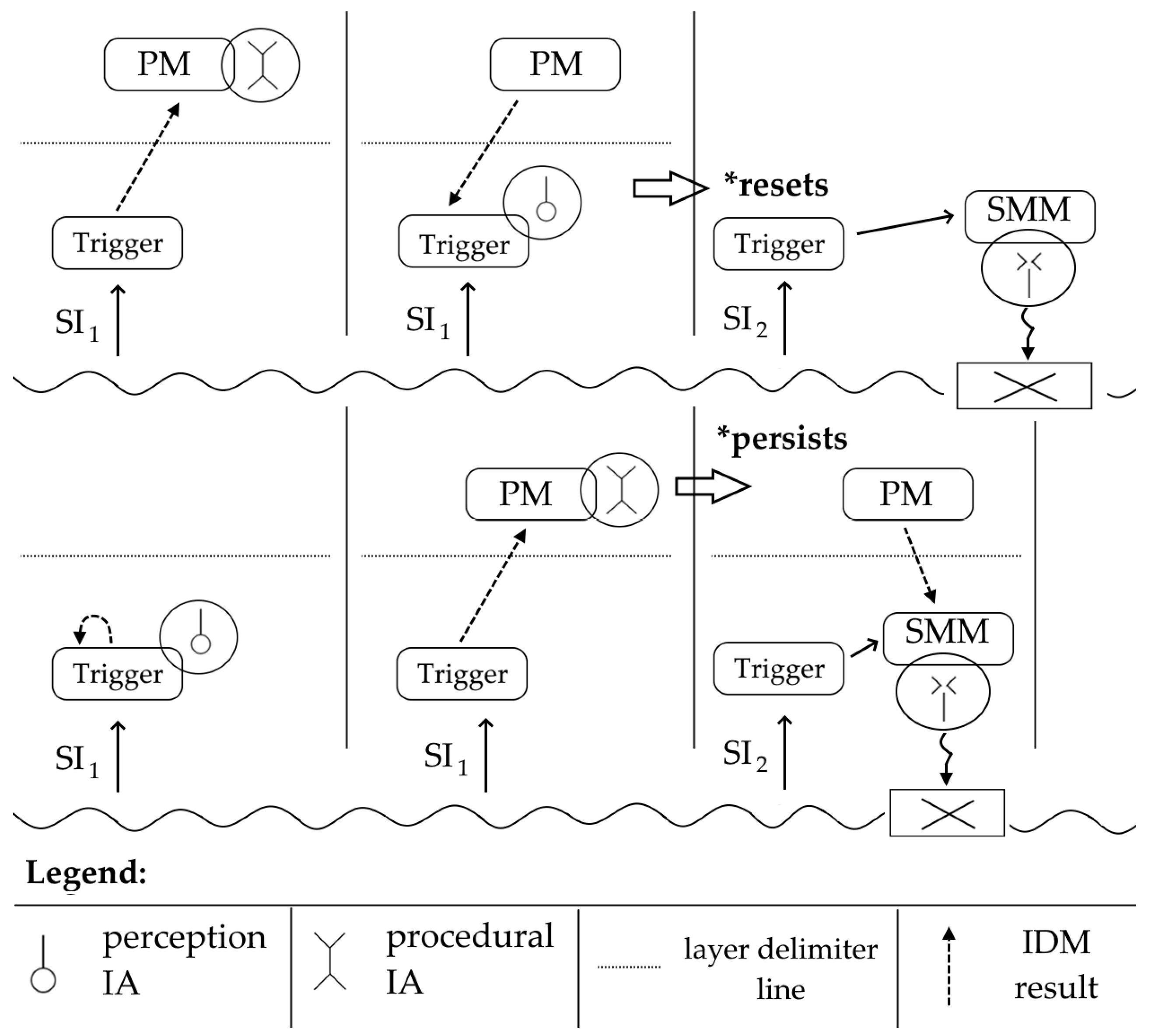
Disclaimer/Publisher’s Note: The statements, opinions and data contained in all publications are solely those of the individual author(s) and contributor(s) and not of MDPI and/or the editor(s). MDPI and/or the editor(s) disclaim responsibility for any injury to people or property resulting from any ideas, methods, instructions or products referred to in the content. |
© 2025 by the authors. Licensee MDPI, Basel, Switzerland. This article is an open access article distributed under the terms and conditions of the Creative Commons Attribution (CC BY) license (https://creativecommons.org/licenses/by/4.0/).
Share and Cite
Ukov, T.; Tsochev, G.; Yoshinov, R. A Monitoring System for Measuring the Cognitive Cycle via a Continuous Reaction Time Task. Systems 2025, 13, 597. https://doi.org/10.3390/systems13070597
Ukov T, Tsochev G, Yoshinov R. A Monitoring System for Measuring the Cognitive Cycle via a Continuous Reaction Time Task. Systems. 2025; 13(7):597. https://doi.org/10.3390/systems13070597
Chicago/Turabian StyleUkov, Teodor, Georgi Tsochev, and Radoslav Yoshinov. 2025. "A Monitoring System for Measuring the Cognitive Cycle via a Continuous Reaction Time Task" Systems 13, no. 7: 597. https://doi.org/10.3390/systems13070597
APA StyleUkov, T., Tsochev, G., & Yoshinov, R. (2025). A Monitoring System for Measuring the Cognitive Cycle via a Continuous Reaction Time Task. Systems, 13(7), 597. https://doi.org/10.3390/systems13070597







